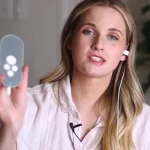On a drizzly Monday morning, a marathon runner glances at her fitness tracker and frowns. Her heart rate variability (HRV) – a number she’s learned to watch as closely as her pace per mile – is unusually low. Meanwhile, across the country, a stressed-out entrepreneur takes a deep breath as he clips a small device to his ear. He’s not making a fashion statement; he’s about to stimulate his vagus nerve in hopes of nudging that HRV number up, calming his mind, and priming his body for the day’s challenges. Once an obscure medical metric, HRV has become the latest prized vital sign for biohackers and peak performers, and new tech like non-invasive vagus nerve stimulators are bringing an ancient bodily circuit under our conscious control.
What Is HRV and Why It Matters
To the untrained eye, a healthy heart beats with metronome-like regularity. But in reality, the timing between each heartbeat – measured as heart rate variability (HRV) – constantly fluctuates by a few milliseconds. Far from a flaw, this subtle variability is a sign of health. HRV reflects how flexibly your nervous system responds to life. Specifically, it’s a proxy for the delicate balance between your “fight-or-flight” sympathetic nerves and the “rest-and-digest” parasympathetic nerves (chiefly carried by the vagus nerve). When you inhale, your heart rate ticks up; when you exhale, it slows down – a seesaw orchestrated by the vagus nerve to keep you in balance. The higher the variability between beats, the more easily you can navigate stress and then recover. In essence, HRV is a barometer of your nervous system’s resilience⁵’⁷.
Researchers have found that a high HRV is generally linked to better outcomes in many domains of physical and mental health. For instance, people with higher HRV tend to handle stress more effectively – they’re literally more heartily resilient – and even show greater cognitive flexibility under pressure⁵’⁸. High HRV has been associated with better emotional regulation and a lower risk of anxiety or depression⁵. It’s also correlated with cardiovascular fitness and longevity: one study of aging found that individuals who maintained higher HRV and lower resting heart rates had reduced risk of heart disease and lived longer on average⁴. On the flip side, low HRV (a sign that your heartbeats are more monotonously regular) often accompanies chronic stress and has been observed in conditions from hypertension to major depression – even serving as a red flag for higher mortality risk⁴’⁷. In short, HRV is emerging as a holistic health metric linking mind and body⁷.
In practical terms, boosting one’s HRV has become a new goal for those seeking optimal wellness. Why? Because higher HRV is associated with:
- Enhanced cardiovascular health: A heart that can speed up or slow down efficiently is generally a strong, adaptable heart⁴’⁵. Conversely, persistently low HRV has been linked to increased risk of arrhythmias and cardiac events⁵.
- Improved stress resilience: People with high HRV often cope better with stressful situations and recover faster afterward⁵’⁸. It’s a sign your nervous system can hit the “brakes” on stress when needed.
- Better athletic performance and recovery: Coaches and athletes monitor HRV as a gauge of training readiness. A high HRV usually means your body is recovered and primed for action, whereas low HRV can signal overtraining or fatigue⁵. Many elite athletes will actually back off training if their morning HRV is low – it’s like checking your body’s battery charge.
- Stronger cognitive and emotional control: HRV is linked to activation of brain areas involved in self-regulation. Higher HRV has been correlated with better focus, decision-making, and emotional stability⁵’⁹. Some psychologists call HRV a marker of emotional resilience – the ability to stay cool and collected.
- Healthy aging: As we age, HRV tends to decline, but those who maintain a higher HRV are often biologically “younger” in terms of neural and cardiovascular health⁴’¹⁰. It’s being studied as a biomarker for longevity and healthy aging, with the idea that preserving your heart’s variability might help you stay robust longer.
These wide-ranging links explain why HRV has captured the attention of everyone from cardiologists and psychologists to fitness gurus. It’s not often that one number connects stress, heart health, mental health, and even longevity – and can be measured from a little sensor on your wrist. Which brings us to the current craze for tracking HRV in everyday life.
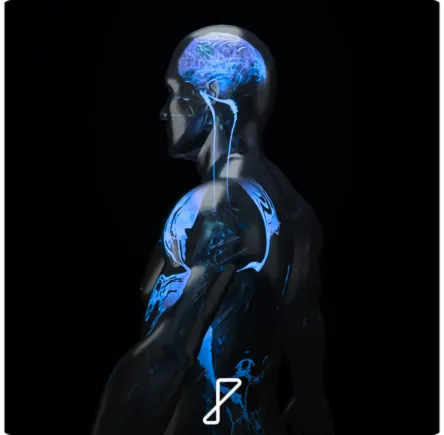
The Vagus Nerve: Your Built-in Calm Switch
If HRV is the score, the vagus nerve is the coach calling the plays. This nerve – actually a pair of nerves – wanders (as its Latin name vagus suggests, like “vagabond”) from the brainstem down into almost every organ, carrying parasympathetic signals that tell your body it’s safe to relax. When you meditate, breathe slowly, or even splash your face with cold water, it’s the vagus nerve that floods the heart with signals to slow down. The result? More variability between beats as your heart eases off the gas pedal and idles gently. In scientific terms, activating the vagus nerve increases HRV by boosting “high-frequency” heart rate oscillations associated with breathing and calm states¹.
For decades, this mind-body nexus was mostly exploited indirectly – through yoga, deep breathing exercises, meditation, or relaxation techniques known to engage the vagus nerve. These absolutely work (ever notice how your heart rate steadies and breathing deepens when you’re truly relaxed?). But in recent years, scientists have gone a step further: why not stimulate the vagus nerve directly to kickstart the calming response on demand?
That idea isn’t entirely new – vagus nerve stimulation (VNS) has been used in medicine since the late 1990s, when surgeons began implanting vagus nerve stimulators in patients with refractory epilepsy. Those devices electrically tickle the vagus nerve in the neck at intervals, reducing seizures (and later, they were used for treatment-resistant depression as well). A curious side effect noted in some VNS patients was changes in heart function – not surprising, since the vagus heavily influences heart rhythm. But early VNS required an invasive surgery to implant a stimulator the size of a pocket watch in the chest, plus electrode leads around the nerve. It was anything but accessible for the average person who just wants less anxiety and a better HRV score.
Enter non-invasive VNS. Researchers discovered that there’s a branch of the vagus nerve reachable from the surface of the body – specifically, in your outer ear. In fact, if you’ve ever felt a weird calm after cleaning your ears or massaging that little ridge on your ear (the tragus or cymba), you might have been stimulating vagus nerve fibers. Several companies and research labs have created devices that send a mild electrical current through the skin of part of the ear to stimulate the vagus, a method called transcutaneous auricular VNS (or taVNS). It’s basically a way to hack the vagus nerve without surgery.
And does it work? Evidence is mounting that stimulating the vagus nerve this way can boost HRV and promote a parasympathetic state. In one recent clinical study, a single 15-minute session of ear electrode stimulation significantly increased HRV measures in healthy adults compared to a sham (placebo) treatment – particularly increasing high-frequency HRV, which is a hallmark of vagal activity³. Notably, this effect was strongest in participants who were older, suggesting that as we age (and baseline vagal tone decreases), we might reap even bigger benefits from a vagus nerve jump-start³. Another 2022 experiment nicknamed “Ear to the heart” found that auricular VNS reliably caused a rapid uptick in multiple HRV parameters (time between beats, variation in successive beats, etc.) within minutes of stimulation, whereas a sham stimulation did not¹. In fact, the authors concluded that HRV can serve as a handy physiological readout to confirm that the vagus nerve is indeed being activated by the device¹.
To be fair, not every study has shown sky-high HRV changes with taVNS – results can vary based on where exactly the electrode is placed on the ear, the current intensity, and differences in study design². A systematic review in 2023 looked at 21 trials of auricular VNS in healthy people and found that the majority reported significant improvements in key HRV metrics (such as SDNN and RMSSD, which are geek-speak for certain measures of beat variability)². But a few studies saw minimal change. The consensus emerging is that vagus stimulation usually increases HRV, especially if one’s baseline vagal tone is low, but there’s an optimal “dose” and technique still being refined². Nonetheless, the ability to tune the nervous system via the ear is one of those almost sci-fi ideas that is rapidly becoming real science. And people are taking notice.
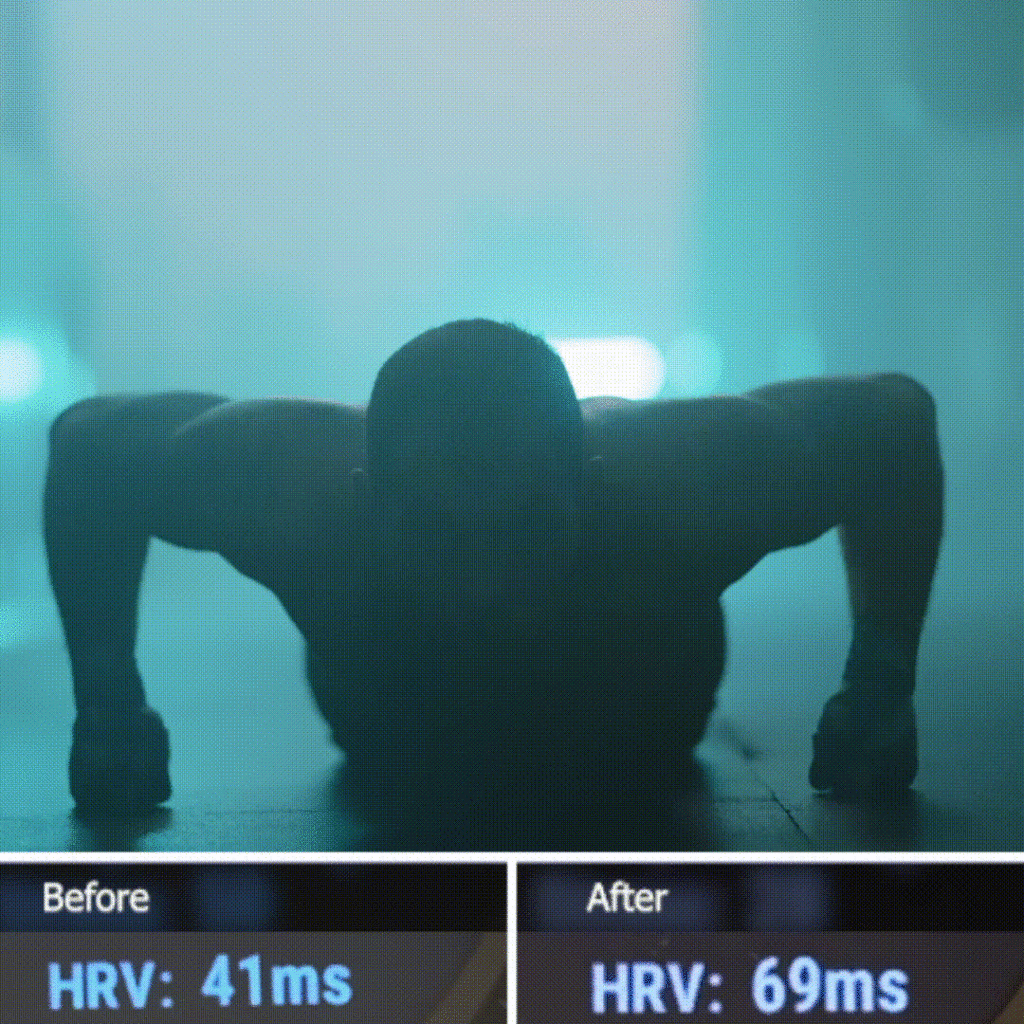
Why HRV Is the Hottest Number in Health Right Now
Part of the reason vagus nerve hacking is taking off now is because HRV itself has gone mainstream. Ten years ago, if you weren’t a cardiologist or a stress researcher, you probably never discussed heart rate variability at dinner. Today, HRV is a buzzword in wellness and sports. You can thank the explosion of consumer wearable tech for that. Modern smartwatches and fitness bands – from WHOOP straps to Oura rings to the latest Apple Watch – all pack in HRV sensors and openly display that metric to users. Tracking one’s HRV over time has become as simple as opening an app. And indeed, monitoring HRV with gadgets has become increasingly popular for people trying to quantify their stress and recovery⁵.
Why are everyday folks suddenly charting a data point that used to live in medical journals? Because it offers a window into something everyone cares about: how stressed am I, and am I recovering well? High-tech athletes led the charge – teams in the NBA and NFL started using HRV readings to individualize training loads (a player with a dip in HRV might get put on a lighter practice schedule to prevent burnout). Biohackers and Silicon Valley execs soon followed, treating their morning HRV reading like a check-engine light for their body’s stress levels. If HRV was low, maybe they’d prioritize meditation that day, or take a cold shower, or avoid a second cup of coffee. If it was high, they might push hard in the gym or tackle that marathon coding session.
The COVID-19 pandemic also played a role in HRV’s rise. Some people noticed their wearables warned them of illness or stress via a dropping HRV before other symptoms hit, prompting interest in HRV as an early warning sign. And in mental health, therapists have used HRV biofeedback (where you try to consciously raise your HRV via breathing techniques) to help patients with anxiety and PTSD learn to shift into calmer states. In short, HRV has graduated from a wonky cardiology statistic to a daily mind-body check-in. As cardiologist Dr. Alberto Colombo put it, “Heart rate variability is like a mirror for your autonomic nervous system – when you look into it, you see the reflection of your stress or your serenity.”
All this enthusiasm to increase HRV has naturally led to an interest in anything that can nudge that number upward. Traditionally, people have tried a gamut of vagus-activating habits: deep breathing exercises, meditation, yoga, singing or humming (which can stimulate vagal pathways in the throat), even splashing cold water on the face (the “diver’s reflex” triggers vagus activity). Endurance exercise training is another proven way to slowly raise baseline HRV – fit individuals often have impressively high HRVs and low resting heart rates. And of course, good sleep, balanced diet, and stress management all support a healthier autonomic nervous system and thus higher HRV over time⁵.
But habits only go so far, and they require time and consistency. This is the 21st century – enter technology. If a few minutes of gentle electrical stimulation could do the work of an hour of meditation, many busy (or impatient) people are more than willing to give it a try. That prospect – a shortcut to a calm, high-HRV state – is exactly what non-invasive vagus nerve stimulation devices promise. It’s biohacking meets neurophysiology: a marriage of wearable tech and age-old wisdom about the power of the vagus nerve.
From Science to Gadget: Bringing Vagus Stimulation Home
Not long ago, if you wanted vagus nerve stimulation, you had to either get surgery or rig some MacGyver-like setup with a TENS (electrical stimulation) unit and hope for the best. (Indeed, some intrepid biohackers have experimented with clipping standard TENS device electrodes to their ear – with very mixed results and safety concerns.) Today, however, a new class of wearable, ear-based VNS devices is emerging, allowing anyone to tap into their vagus nerve at home with the press of a button.
One standout example is Nurosym, a CE-certified vagus nerve stimulator that has garnered attention for its ease of use and clinical pedigree. Nurosym looks a bit like a sleek remote control with wired ear clips. To use it, you dampen the small electrode clips and attach them to the tragus area of your left ear – right where the vagus nerve’s auricular branch resides⁶. Press the power button, and the device delivers a carefully calibrated electrical pulse that you might feel as a mild tingling in the ear. In just 15–30 minutes a day, the goal is to painlessly prod your vagus nerve into a more active state, effectively training your parasympathetic “rest and digest” response to be stronger.
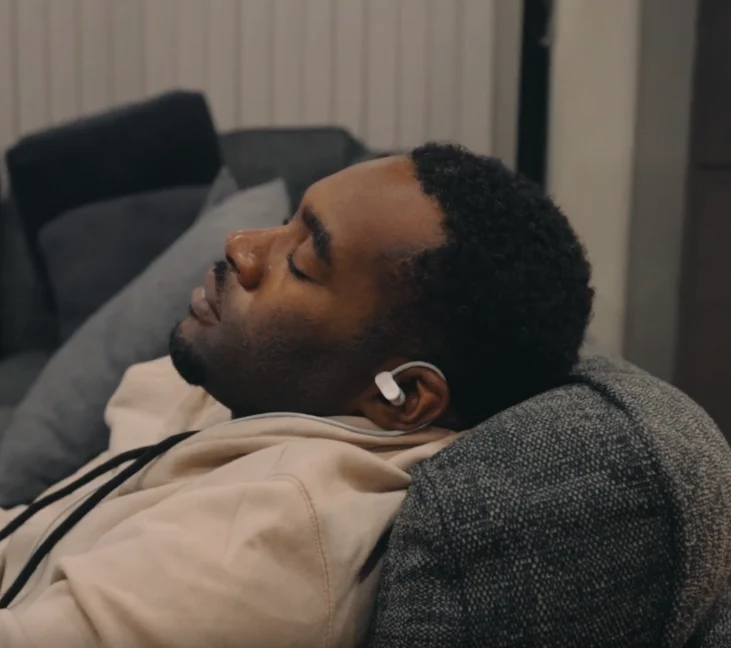
Figure: A user demonstrates Nurosym’s ear-clip vagus nerve stimulator. Non-invasive devices like this deliver gentle electrical pulses via the ear’s vagal fibers to activate the parasympathetic nervous system. The result is an increase in vagal tone and heart rate variability, promoting a state of calm and improved resilience.
Devices like Nurosym set themselves apart from earlier DIY approaches by undergoing rigorous testing and being designed with safety controls. In fact, Nurosym touts itself as “the only scientifically tested wearable vagal neuromodulation device” of its kind⁶ᴬ. It’s a certified medical device in Europe (bearing a CE mark as a non-invasive vagal neuromodulation system) and was studied in collaboration with researchers at institutions like Harvard Medical School and Imperial College London⁶,⁶ᴬ. Over $10 million has been invested in its clinical research and technology, and the company claims more than 4 million VNS sessions have been safely completed with zero serious adverse events reported in studies to date⁶ᴬ’ᴮ. In other words, this isn’t a sketchy internet gadget with no data – it’s been put through its paces in labs and trials.
What do those trials show? According to Parasym, the neurotechnology company behind Nurosym, the device’s impact on the vagus nerve and HRV is significant. In their published results, they report that vagus nerve activity jumps by about 61% within just 5 minutes of using Nurosym, and by 90% after two months of daily use⁶. Users’ heart rate variability increased around 18% on average alongside those gains in vagal tone⁶. Such changes aren’t just numbers on a chart – they have real-life implications. For example, clinical evaluations have noted parallel improvements in conditions linked to chronic stress and low vagal activity: patients have seen reductions in fatigue, brain fog, and inflammatory markers, improved sleep quality, and even lifting of depressive symptoms, all coinciding with increased HRV after consistent vagus nerve stimulation⁶. These are early findings, but promising enough that over 60 medical centers and universities worldwide are either using or studying the device⁶.
Of course, the experience of the individual user matters just as much as the clinical data. And anecdotal reports from Nurosym users echo the scientific story. “For me, it is a groundbreaking tool for both wellness and performance enhancement,” says Henry, a beta user who incorporated the device into his training routine. “The benefits I’ve experienced include a measurable reduction in stress, improved recovery metrics as measured by my WHOOP device, and an increased ability to focus or train for long periods of time”⁶ᴬ. In other words, his HRV didn’t just improve on a graph – it translated to feeling less frazzled and performing better in daily life. Another early adopter, a physician-researcher, noted that vagus stimulation with Nurosym “can be seen as the main switch on recovery,” pointing out that in even a single-person trial he could observe parasympathetic activation in real time⁶ᴬ.
What makes a device like Nurosym compelling is not that it replaces healthy habits like exercise or meditation – in fact, many users do both – but that it potentially augments them. It gives people a degree of direct control over their physiology that they never had before. Feeling anxious before a big presentation? Clip on the device for 15 minutes of vagus nerve calming. Hard workout yesterday? Use it in the evening to speed recovery. It’s no magic cure-all, but as one user put it, “it’s like having a meditation facilitator or a neural tune-up at the push of a button.”
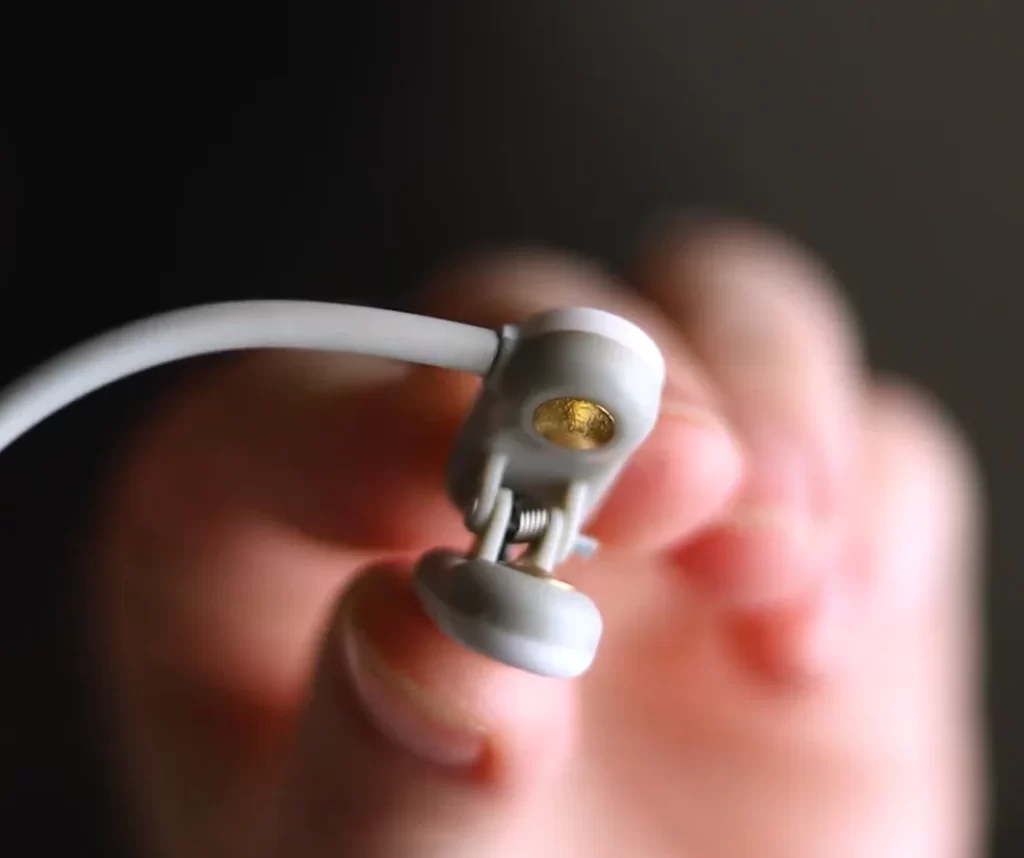
A Note on Safety and DIY Alternatives
Whenever a new wellness tech trend comes along, skeptics rightly ask: is this safe, and how is it different from cheaper alternatives? In the case of auricular VNS devices, safety profiles so far appear favorable – the currents are extremely low (microcurrents) and targeted. The main side effects reported have been minor skin irritation at the clip site or a tingling sensation. Because devices like Nurosym have built-in limits and protocols (and have been tested for things like optimal frequency and pulse width), they mitigate the risk of over-stimulation. This isn’t always the case with do-it-yourself methods. Users who jury-rig their own vagus nerve stimulators with random electrodes or those trying unregulated gadgets might not get the placement or dosage right – and at best they feel nothing, at worst they could cause pain or bradycardia (over-slowing of the heart). Nurosym’s team emphasizes clinical validation and consistent, reproducible stimulation parameters – a big part of why it earned medical device certification⁶.
That said, non-electrical methods of stimulating the vagus nerve are still worthwhile and complementary. Many Nurosym users continue practicing deep breathing or meditation; in fact, combining these techniques might compound the benefits. Think of vagus nerve stimulation as adding another tool to your stress-management toolbox, not throwing out the rest. And while Nurosym is currently one of the frontrunners with strong scientific backing, a few other companies are exploring similar territory – from neck-based stimulators to wearable pendants that claim to activate vagal pathways through sound and vibration. We are at the beginning of what looks to be a new era of “electroceuticals” – using targeted electricity to nudge the body toward health, rather than drugs.
The Future of HRV Hacking
It’s a rare convergence when cutting-edge neuroscience and consumer tech align with an ancient wellness principle. The vagus nerve has been quietly keeping humans alive and balanced for millennia; now we’re finally giving it the spotlight it deserves. Heart rate variability, likewise, has been a hidden signal of well-being – now it’s becoming as watched by health enthusiasts as cholesterol or blood pressure. The marriage of the two – boosting HRV via vagus nerve stimulation – could herald a new kind of personalized medicine: one that’s less about treating disease and more about optimizing our baseline state so we can handle whatever life throws at us.
In the near future, don’t be surprised if HRV-checking becomes as routine as stepping on a scale, and if devices like Nurosym become as commonplace as home blood pressure cuffs. Executives might use them before high-stakes meetings to enter a focused calm state. Therapists might send anxious patients home with a “vagal stim” prescription to practice alongside mindfulness. Athletes might recover faster between games by electrically enhancing their body’s natural recovery mode. And yes, maybe some weekend warriors will use them to feel a bit more zen during rush-hour traffic.
The core idea is profound: we are learning to control what was once automatic. We can dial our stress responses up or down not just with our thoughts, but with gentle electronic nudges. It’s biofeedback in action – your body gets a signal to relax, your heart rhythm follows suit (HRV rises), and you subjectively feel calmer and more focused. Over time, this could even train your baseline vagal tone to be higher, meaning your default state becomes more relaxed yet resilient. That has implications not just for wellness, but potentially for how we approach mental health, aging, and preventive medicine.
In an age where stress-related ailments run rampant, this nexus of technology and neuroscience offers a hopeful narrative: perhaps the key to longevity and peak performance isn’t found in a pill or a genome, but in the gentle whisper of a nerve we’ve had inside us all along – now finally amplified by a little modern ingenuity. As the marathoner finishes her run and checks her app – HRV back up after a recovery session – and the entrepreneur unclipping his vagus stimulator heads into a busy workday feeling unusually centered, one can’t help but think: the future of resilience might just be electric.
Sources:
- Forte, G. et al. (2022). Ear your heart: transcutaneous auricular vagus nerve stimulation on heart rate variability in healthy young participants. PeerJ, 10, e14447. – Demonstrated that stimulating the cymba conchae region of the ear reliably increases HRV in minutes, supporting HRV as an indicator of vagal activation pmc.ncbi.nlm.nih.gov.
- Soltani, D. et al. (2023). Transcutaneous auricular VNS on baroreflex sensitivity and HRV in healthy subjects: a systematic review. Clin Auton Res, 33(2), 165-189. – Reviewed 21 studies; most showed significant improvements in HRV parameters with ear-based vagus stimulation, though results varied by protocol , pubmed.ncbi.nlm.nih.gov.
- Gianlorenço, A.C. et al. (2024). Age as an effect modifier of taVNS on HRV in healthy subjects. Brain Sci, 14(8), 175. – Found a single session of taVNS significantly increased high-frequency HRV (parasympathetic indicator) vs sham, especially in older adults pmc.ncbi.nlm.nih.gov.
- Wiersema, J.M. et al. (2022). Continuous ambulatory HRV and familial longevity. Aging (Albany NY), 14:7223-39. – Reported that lower HRV is linked to higher mortality risk, while better longevity is associated with higher HRV and lower resting heart rate aging-us.com.
- Mark Hyman, MD – “The Science of Heart Rate Variability” (2023, drhyman.com blog) – Explains HRV’s health implications in lay terms. Notes that higher HRV correlates with better emotional resilience and cardiovascular fitness, and that tracking HRV with Apple Watch, Whoop, Oura, etc., has become popular for optimizing training and stress recovery drhyman.com drhyman.com.
- Parasym (Nurosym) – Product Literature and Clinical Results (2023). – Claims Nurosym’s trials show ~18% increase in HRV with daily use, a 61% acute increase in vagal activity, and broad benefits (reduced inflammation, improved mood, etc.) from enhanced vagal toneconsciousspaces.com consciousspaces.com. The device is CE-marked and tested in 30+ peer-reviewed studies, used at institutions like Harvard and Imperial College consciousspaces.comconsciousspaces.com. A. User reports include improved stress metrics and recovery as measured by independent wearables (e.g. WHOOP)nurosym.com. B. nurosym.com
- Gianlorenço, A. C., Pacheco-Barrios, K., Daibes, M., Camargo, L., Choi, H., Song, J. J., & Fregni, F. (2024). Age as an Effect Modifier of the Effects of Transcutaneous Auricular Vagus Nerve Stimulation (taVNS) on Heart Rate Variability in Healthy Subjects. Journal of clinical medicine, 13(14), 4267. pmc.ncbi.nlm.nih.gov pmc.ncbi.nlm.nih.gov
- Zeng, J., Meng, J., Wang, C., Leng, W., Zhong, X., Gong, A., Bo, S., & Jiang, C. (2023). High vagally mediated resting-state heart rate variability is associated with superior working memory function. Frontiers in Neuroscience, 17. semanticscholar.org
- Forte, G., Morelli, M., Grässler, B., & Casagrande, M. (2022). Decision making and heart rate variability: A systematic review. Applied Cognitive Psychology, 36(1), 100–110. https://doi.org/10.1002/acp.3901 onlinelibrary.wiley.com
- Singer, D. H. (2010). High heart rate variability, marker of healthy longevity. American Journal of Cardiology, 106(6), 910. https://doi.org/10.1016/j.amjcard.2010.06.038 ajconline.org
Teilen über:


